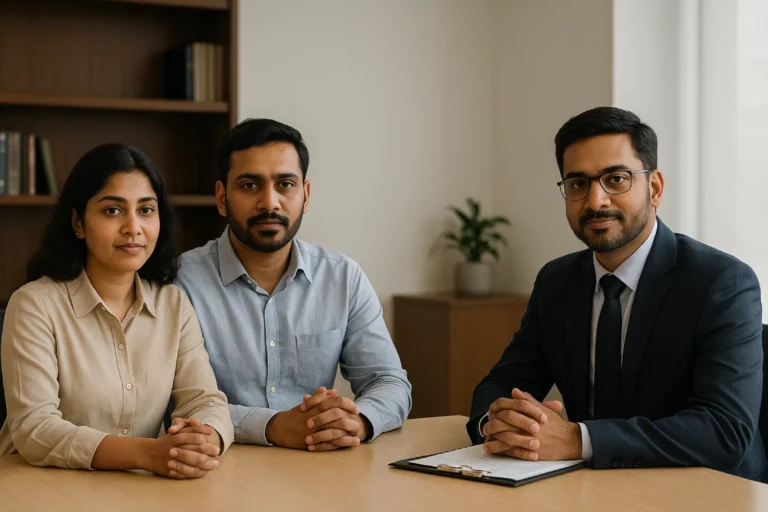Alimony in Divorce: Avoid Costly Mistakes in India Types
Alimony in divorce (often called alimony and spousal support or maintenance) is not a fixed percentage in India. Courts assess need and ability to pay using factors like income, standard of living, marriage duration, health, childcare, and conduct. Relief may be interim (during the case) or permanent (in the final decree), through monthly sums or a lump sum.
Key provisions include Section 24 and Section 25 of the Hindu Marriage Act, 1955, Sections 36 & 37 of the Special Marriage Act, 1954, and Section 144 of the Bharatiya Nagarik Suraksha Sanhita, 2023 (successor to CrPC 125) for quick, secular maintenance.
Important: This article offers general information only. It is not legal advice. Outcomes depend on specific facts and documents. For personalised guidance, consult a qualified lawyer.
What does “alimony in divorce” cover in India?
In simple terms, alimony and spousal support ensure a reasonable standard of living for the financially weaker spouse. The law recognises that one partner may have paused a career, undertaken primary childcare, or otherwise become economically dependent. Relief can be sought during the proceedings (interim/pendente lite) and after the decree (permanent maintenance). BNSS Section 144 also provides a fast‑track maintenance remedy irrespective of religion.
Alimony in divorce means court‑ordered financial support to ensure a fair, dignified post‑separation life for a dependent spouse. It may be interim or permanent, monthly or lump sum, and is calibrated to meet individual needs and capacity.
Legal framework at a glance
India uses a mix of personal laws and a secular maintenance remedy. For Hindus: Hindu Marriage Act (HMA) Sections 24 & 25. For civil/inter‑faith marriages: Special Marriage Act (SMA) Sections 36 & 37. For quick, secular relief across communities: BNSS 2023 Section 144.

The governing provisions are HMA 24–25 (either spouse, pendente lite and permanent), SMA 36–37 (alimony to the wife in SMA matters), and BNSS 144 (maintenance for wives, children, and parents). Each has distinct procedures and remedies.
Key points
- HMA, 1955
- Section 24: Interim maintenance & litigation expenses when a spouse lacks sufficient independent income.
- Section 25: Permanent alimony/maintenance to either spouse; modifiable for changed circumstances; can cease on remarriage/chastity clauses per statute.
- Section 24: Interim maintenance & litigation expenses when a spouse lacks sufficient independent income.
- SMA, 1954
- Section 36: Alimony pendente lite to the wife during proceedings; 60‑day disposal guideline for applications.
- Section 37: Permanent maintenance to the wife may be secured by a charge on property.
- Section 36: Alimony pendente lite to the wife during proceedings; 60‑day disposal guideline for applications.
- BNSS, 2023 Section 144 (successor to CrPC 125)
- Summary remedy for wives, children, and parents when a person with means neglects/refuses to maintain them; includes interim maintenance and a 60‑day timeline for such applications.
- Summary remedy for wives, children, and parents when a person with means neglects/refuses to maintain them; includes interim maintenance and a 60‑day timeline for such applications.
Note on terminology: In Indian practice, alimony, maintenance, and spousal support are often used interchangeably. This article uses alimony and spousal support broadly, and maintenance after divorce for post‑decree support.
Primary factors courts consider while fixing alimony and spousal support
Courts do not use a flat percentage. They balance need and capacity with an eye on fairness. Documentary proof is critical affidavits of income/assets, bank statements, ITRs, rental deeds, and necessary expenses.

Judges calibrate alimony in divorce by weighing need vs. capacity, lifestyle during marriage, duration, health, employability, caregiving duties, and conduct supported by financial disclosures and evidence to avoid over‑ or under‑compensation.
Typical evaluation factors
- Income, assets & liabilities of both sides: salary/slips, business income, rental returns, EMIs, debts, dependents.
- Standard of living during marriage: housing, schooling, vehicles, travel aim is reasonable continuity, not windfall gains.
- Marriage duration & interdependence: Longer marriages often justify longer or higher support.
- Age, health, and special needs: illness/disability increases reasonable needs; medical insurance/expenses are weighed.
- Earning capacity & employability: education, skills, work gaps from childcare or homemaking weigh in.
- Childcare and custody burdens: direct and indirect costs, time off work, and stable housing for children.
- Conduct limited to statutory relevance: cruelty/adultery can affect maintenance under specific provisions; proof standards apply.
Difference between interim and permanent alimony
Interim (pendente lite) alimony sustains a spouse during the case, quickly decided on a broad‑brush view. Permanent alimony is part of the final decree, based on fuller evidence, and is modifiable for material change.

Interim/Pendente lite (HMA 24; SMA 36; BNSS 144)
- Purpose: keep the playing field level during litigation.
- Coverage: essential living costs, sometimes litigation expenses.
- Tempo: applications are intended to be decided as far as possible within ~60 days.
- Proof: prima facie income/needs; the court avoids mini‑trials.
Permanent (HMA 25; SMA 37)
- Granted in the decree or later on application.
- Forms: monthly/periodic payments or lump‑sum (one‑time) settlement.
- Review: can be varied/rescinded for material change (job loss, illness, remarriage, cohabitation where relevant to statute).
Types of Alimony (forms of payment)
Courts may order monthly/periodic payments for ongoing support or a single lump sum to achieve finality. Each option has pros/cons in enforcement, certainty, cash flow, and future modification.
Monthly/periodic maintenance
- Pros: steady support; adjustable if circumstances change.
- Cons: ongoing enforcement risk; future disputes about increases or arrears.
Lump‑sum (one‑time) alimony
- Pros: closure, no monthly friction; enforcement completed upfront.
- Cons: needs liquidity; recipient must budget prudently; usually non‑modifiable.
Hybrid structures
- Part lump‑sum for setup costs (security deposit, relocation) + reduced monthly amounts for stability.
How courts estimate a fair amount in alimony and spousal support
There is no universal formula. Courts triangulate disclosed income, reasonable budgets, children’s needs, and lifestyle markers to prevent hardship without enriching either side. Documentation quality strongly influences outcomes.

Evidence that typically matters
- Last 3 years’ ITRs, salary slips, balance sheets, bank statements.
- Rental deeds/maintenance bills; loan/EMI schedules; insurance premiums; medical records.
- School fee charts, childcare invoices, transport, and after‑school costs.
- Proof of job search/training efforts by the dependent spouse.
Calibration themes from case law
- Rajnesh v. Neha (2020, SC): standardised disclosure affidavits; avoid duplicate claims under overlapping laws; consider realistic earning capacity, reasonable needs, and prompt payment from the application date where appropriate.
- Orders often charge amounts on property (SMA 37) or use execution tools for compliance; pendente lite aims to avoid hardship, not to pre‑judge merits.
Maintenance after divorce: modification, suspension, and enforcement
Post‑decree maintenance can change if life changes. Non‑payment invites execution, attachment, or contempt. Certain events, like remarriage or unchastity clauses under HMA 25(3) may lead to variation or rescission by the court.
Modification examples
- Material change: serious illness, job loss, or a significant pay cut/pay rise.
- Remarriage/new cohabitation, where relevant under statute.
- Children’s needs: special education/medical costs.
Enforcement toolkit
- Execution: attach salary/bank accounts; create a charge on immovable property.
- Contempt for willful disobedience; costs and interest on arrears.
- BNSS 144: summary process designed to prevent destitution with interim support while larger disputes continue elsewhere.
Frequently asked practical questions
These short answers demystify common doubts on alimony in divorce timelines, eligibility for husbands, tax considerations, and interaction between cases.
Is there any fixed percentage of income awarded as alimony in divorce?
No. Courts tailor awards to need and capacity. Thumb rules or internet “percentages” are unreliable.
Can husbands ever claim support?
Under HMA Section 24/25, either spouse may seek pendente lite or permanent maintenance based on need. Under SMA, the text of Sections 36–37 provides relief to the wife.
How fast can interim maintenance be decided?
Both HMA 24 and SMA 36 contain a 60‑day disposal intent “as far as possible.” BNSS 144 also envisages interim maintenance during pendency.
Can I seek BNSS 144 maintenance and also ask for alimony in the divorce?
Courts try to avoid duplication. Relief under one forum is usually considered when fixing amounts elsewhere. Disclose all proceedings; amounts are adjusted to prevent double recovery.
Will maintenance stop if I remarry?
Under HMA 25(3), courts may vary or rescind maintenance on such events; details depend on facts and the exact order terms.
Is alimony taxable?
Tax treatment can be nuanced (lump‑sum vs periodic). Seek advice from a tax professional; do not rely on generic rules.
Documents and preparation checklist for a stronger case
Good preparation often matters more than rhetoric. Use this checklist to organise disclosures, budgets, and proofs of genuine need or limited capacity so the court can calibrate alimony and spousal support fairly.
- Affidavit of disclosure (income/assets/liabilities, per Rajnesh v. Neha templates).
- ITRs and salary/balance sheets for 3 years; bank statements.
- Housing: rent agreement, maintenance bills, utility bills.
- Children: school/tuition/transport/medical bills; caregiver invoices.
- Healthcare: prescriptions, insurance premiums, chronic‑care costs.
- Job search/training: applications, course enrolments, certificates.
- Major life changes: medical reports, layoff letters, and new dependent proofs.
Misconceptions to avoid in alimony and spousal support
Myths lead to bad strategy, like hiding income, over‑claiming budgets, or assuming fault always decides maintenance. Courts focus on evidence and fairness, not theatrics or intimidation.
- “A set percentage will be awarded.” There’s no statutory formula.
- “Fault automatically decides maintenance.” Not under all provisions; conduct is relevant in specific ways.
- “I can hide cash income and win.” Non‑disclosure backfires; courts draw adverse inferences.
- “BNSS 144 is only for Hindus.” It is a secular, summary remedy.
- “Lump‑sum is always better.” It depends on liquidity, risk tolerance, and enforcement concerns.
Key takeaways on alimony in divorce (at a glance)
There is no one‑size‑fits‑all figure for alimony and spousal support. Prepare disclosures early, document genuine needs, and choose the right forum. Expect pendente lite for immediacy and a tailored final order later.
- Primary goal: prevent hardship; preserve reasonable dignity.
- No fixed percentage; evidence‑led calibration.
- Interim vs permanent: different purposes and proof standards.
- Forms: monthly vs lump‑sum (or hybrid) depending on realities.
- BNSS 144: quick, secular maintenance; coordinates with other proceedings.
- Variation/enforcement: plan for life changes and compliance.
Legal references
These primary materials help you verify the statutory position. Case‑law evolves; always check the latest version and seek professional advice before relying on any single judgment.
- Hindu Marriage Act, 1955 full text (India Code PDF); see Section 24 (maintenance pendente lite & expenses) and Section 25 (permanent alimony & maintenance; variation/remarriage clauses).
- Special Marriage Act, 1954 full text (India Code PDF); relevant provisions include Section 36 (alimony pendente lite to wife) and Section 37 (permanent alimony & maintenance to wife; charge on property).
- Bharatiya Nagarik Suraksha Sanhita, 2023 India Code (Act page); see Section 144 (order for maintenance of wives, children, and parents; interim maintenance; 60‑day intent). For a consolidated copy, see PRS India PDF.
- Supreme Court: Rajnesh v. Neha (2020) disclosure affidavits (see Annexures); guidance on overlapping jurisdictions; commencement date of maintenance; factors for quantification.
Need confidential, case‑specific help?
If you’re navigating alimony in divorce, confused by interim vs permanent relief, worried about delayed payments, or unsure what documents will convince the court, timely, precise guidance matters. Speak to Prashastha Legal, Advocates & Solicitors.







